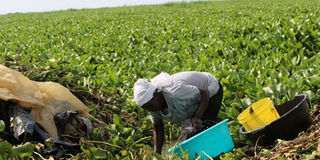Stubborn water weed offers nutritious fertiliser and biogas

A woman cleans basins in Lake Victoria, amid water hyacinth plants in Homa Bay. Despite its stubbornness, the plant can be used in manure making among other uses. FILE PHOTO | NATION MEDIA GROUP .
What you need to know:
- The plant is considered one of the most productive on earth and the worst aquatic weed because of its high vegetative growth, making it a serious threat to biodiversity.
- It grows rapidly as a dense green mat over stagnant water bodies such as lakes, streams, ponds, waterways, ditches and backwaters and is recognised by its lavender flowers and shinning bright leaves.
- Its roots can absorb plant nutrients and keep them into its trunks and leaves, which improves physical properties of soil, soil structure, ventilates the soil and makes it easy for water percolation.
- Currently in Kenya, many innovative farmers are replacing the expensive inorganic fertiliser like DAP, 23:23:0 and CAN with such manures from water hyacinth.
Water hyacinth, botanically called Eichhornia crassipes, is a free-floating perennial hydrophyte (water-loving) plant that grows ubiquitously in natural water bodies in the tropics, including lake Victoria and Naivasha.
The plant is considered one of the most productive on earth and the worst aquatic weed because of its high vegetative growth, making it a serious threat to biodiversity.
Hyacinth is euryhaline, that is it tolerates both fresh and marine water, hence it spreads at an alarming rate in water bodies.
It grows rapidly as a dense green mat over stagnant water bodies such as lakes, streams, ponds, waterways, ditches and backwaters and is recognised by its lavender flowers and shinning bright leaves.
They have broad, thick, glossy, and ovate leaves and floats above the water surface. They also have long, spongy and bulbous stalks with feathery, freely hanging roots that are purple-black.
The plant tolerates annual temperatures ranging from 21.1°C to 27.2°C and its pH tolerance is estimated at 5.0 to 7.5. In Lake Victoria, it has become a menace since it is uncontrolled.
The plant has inhibited fishing, swimming, travelling on boats and other recreational activities associated with lakes and rivers and threatens to wipe out livelihoods.
Despite all the problems, water hyacinth has tremendous merits. It contains 64 per cent methane and can that can be used for biogas generation and for water purification.
It is also valuable in traditional medicine, mushroom bedding material, carbon black production, making of ropes, production of fibre boards, as animal fodder and fish feed, green manure, compost, and as an ornamental plant.
As organic fertiliser, water hyacinth produces pathogen-free rich compost (75.8 per cent organic matter), which increases soil fertility, thereby improves the soil due to its low and narrow margin carbon: nitrogen ratio (C:N) of 1:24.3 with a lignin content of only 9 per cent compared with C:N ratio of 1:80 and lignin content of 17 per cent in wheat straw.
Its roots can absorb plant nutrients and keep them into its trunks and leaves, which improves physical properties of soil, soil structure, ventilates the soil and makes it easy for water percolation.
SOURCE OF MANURE
Chemically, hyacinth add nutrients to soil which may include 1.5 per cent N, 28.7 per cent K2O, 1.8 per cent Na2O, 12.8 per cent CaO, 21 per cent, Cl, and 7.0 per cent P2O5 when dry.
It also naturally absorb pollutants, including toxic chemicals such as lead, mercury, and strontium 90 (as well as some organic compounds believed to be carcinogenic) in concentrations 10,000 times that in the surrounding water.
How to use water hyacinth as green manure
Water hyacinth can be used either as green manure or compost, which may be either ploughed into the ground or used as mulch to cover soil surface while growing crops.
The residues are left for 5-7 days to dry after removing them from water then mixed with ash, soil and some animal manure.
This will allow microbial decomposition to take place, which breaks down fats, lipids, proteins, sugars and starches into humus (C).
The mixture is left in piles to compost for up to three months for the process to produce rich pathogen-free compost that can be applied directly into the soil.
Once applied, the compost increases soil fertility and crop yield and generally improves the quality of the soil.
Currently in Kenya, many innovative farmers are replacing the expensive inorganic fertiliser like DAP, 23:23:0 and CAN with such manures from water hyacinth.
The manure also contains many trace elements (FE, Zn, Mn and Mg), which are rarely found in inorganic fertilisers.
The components help plants to be more disease resistant and enhances quality of produce mainly fruits and vegetables.
It is, therefore, recommended to use water hyacinth as source of manure as it will help reduce its environmental hazards like degrading water quality, curtailing reduction in water movement, clogging of irrigation, hindrance of water transport, blockage of canals and rivers causing flooding as is the case in Kenya now.
Prof Kimurto is a Crop expert and the Director of Agro-Science Park at Egerton University.




